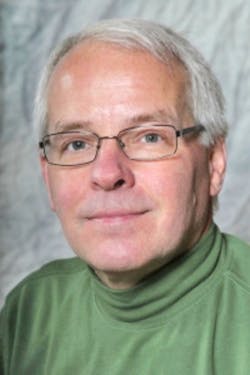APEC speakers cover deep sea to deep space, microwatts to kilowatts
San Antonio, TX. APEC is underway, with Monday plenary-session presenters covering a range of topics, from deep sea to deep space and from microwatts to kilowatts. APEC-related activities commenced Saturday with the Power Sources Manufacturers Association (PSMA) and the IEEE Power Electronics Society (IEEE PELS) sponsoring workshops on capacitors in power-electronics and power magnetics at high-frequency. All day Sunday and Monday morning saw professional education seminars on topics including soft switching, thermal and reliability modeling and management, wide-bandgap technology, inverter design, microgrids, EMI and EMC, GaN technology, energy storage, and IGBT and SiC devices and modules. At the Monday afternoon plenary session, general chair Eric Persson said hundreds attended the preliminary events.
Delivering the first of several presentations at the plenary session, Adam L. Hamilton, P.E., president and CEO of Southwest Research Institute (SwRI) said his organization is involved in applications extending from deep sea to deep space, but they all have one thing in common—the need for power. And the power must be delivered in the harsh environments afforded by deep-sea hydrothermal vents or the radiation of failed reactor cores.
One project SwRI is involved in, he said, is CYGNSS, which monitors GPS signals reflected off the ocean surface to help predict the path of storms. CYGNSS satellites, he said, operate in low orbit and cycle through light and darkness many times a day. Consequently, they require effective power-management functionality delivered by low-cost, lightweight components.
Hamilton cited yet another project—New Horizons, which flew by Pluto at low altitude in 2015, collecting “incredible data.” On New Years Day 2019, it will encounter an object known as “2014 MU69.” Since its launch in 2006, New Horizons has been powered by a radioisotope thermoelectric generator that can deliver a maximum power of 300 W. “But we can do a lot with that,” he said.
In general, he said, the goal is to conduct “incredible science enabled by reliable power provided by onboard power components expected to work flawlessly in space where temperature extremes and ionizing radiation make the environment very challenging.”
SwRI, Hamilton emphasized, addresses applications from deep sea to deep space and practically everything in between. “I think that applies to your industry as well,” he told APEC attendees.
Also addressing the APEC plenary session was Zoya Popovic, Distinguished Professor and Lockheed Martin Endowed Chair, Electrical, Computer, and Energy Engineering at the University of Colorado, Boulder. Her presentation was titled “WPT: from mW/cm2 Harvesting to kW Capacitive Vehicle Powering.”
Introducing her, Persson said she didn’t consider herself part of the power-electronics community but rather part of the RF community. Nevertheless, she told attendees, she works with power-electronics colleagues to improve microwave power efficiency.
Popovic noted that with wireless power transfer, some say wires will no longer be necessary. (Her talk concluded with an image of birds hovering without support between two light poles with no wires, commenting on how unsettling the wireless world had become.) However, she said, it is always more efficient to plug into your power source, but in some cases that is not possible.
She outlined the key methods of wireless power transfer and their pros and cons:
- Reactive near-field coupling supports high power levels but is sensitive to alignment.
- Far-field directive techniques, pioneered by Raytheon, which sent significant levels of power for more than a kilometer, require large antennas for narrow beams.
- Far-field flooding is nondirective and low-power—it is suitable for low-duty-cycle applications (involving sensors, for example) where efficiency is not all that important.
- Multimode techniques support medium-power, multiple-device applications.
Popovic delved into low-power far-field harvesting applications, in which you are trying to extract energy from known or unknown transmitters over a broad frequency range. She commented that as an RF engineer she needed to include a Smith chart in her presentation, facetiously saying that power-engineer attendees owned the two points representing shorts and opens, while RF engineers own everything else. She acknowledged, however, that there are no perfect opens and shorts.
She cited several examples of wireless power transfer from microwatts to kilowatts. In the former, she cited a low-duty-cycle patient health monitoring system that draws 5 mW to transmit 100 bits every five seconds and an aircraft wing corrosion monitor that harvests energy from an altimeter’s sidelobe transmissions. Regarding higher power transmissions, she described work on a capacitive-coupling technique to power an electric vehicle from metal plates embedded in a road while maintaining safety requirements.
She concluded her talk with an extensive bibliography, available to APEC attendees.
About the Author

Rick Nelson
Contributing Editor
Rick is currently Contributing Technical Editor. He was Executive Editor for EE in 2011-2018. Previously he served on several publications, including EDN and Vision Systems Design, and has received awards for signed editorials from the American Society of Business Publication Editors. He began as a design engineer at General Electric and Litton Industries and earned a BSEE degree from Penn State.
